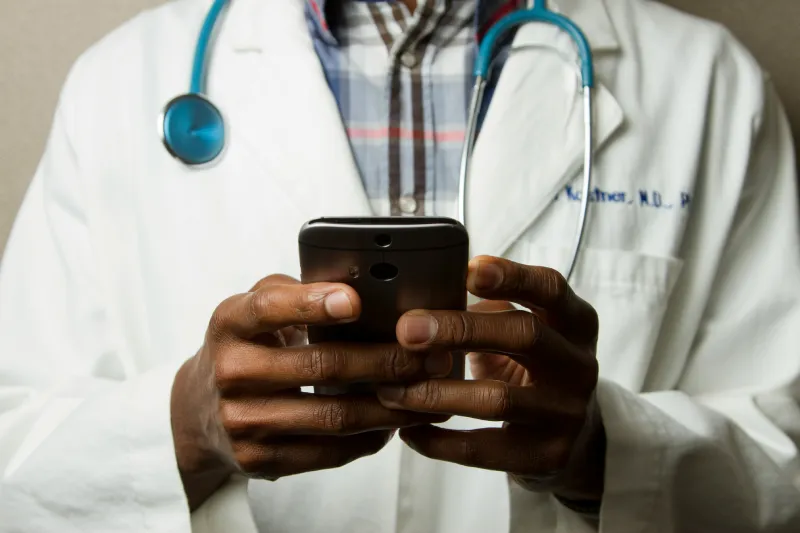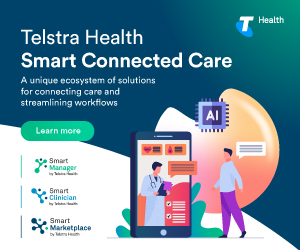What is FHIR and why is it important in healthcare?
FHIR, or Fast Healthcare Interoperability Resources, is an open-source standard for healthcare data exchange.
FHIR enables the exchange of healthcare information between different electronic health systems, making it possible for healthcare providers to seamlessly share patient information across different platforms and organisations.
The interoperability that FHIR enables is essential for providing high-quality care to patients, reducing errors and redundancies, and improving the overall efficiency of the healthcare system. FHIR is helping to shape the future of connected healthcare in Australia and around the world.
At MedicalDirector by Telstra Health, we are continuing to invest in providing greater interoperability to our cloud-based practice management software, Helix, by utilising newer versions of FHIR and a Clinical Data Repository. FHIR is also already used across a range of other Telstra Health solutions and platforms.

Importance of FHIR in Modern Healthcare
FHIR isn’t just a modern way of approaching healthcare. It allows organisations to move forward at warp speed, placing the patient firmly at the centre of the care system.
The first, and most obvious, benefit of FHIR for healthcare organisations is its capacity to streamline data interoperability within and between organisations; this means improved efficiency surrounding data retrieval, fewer errors, and faster, more reliable decision-making.
Of course, the most important feature of any healthcare innovation is improved outcomes for patients. With FHIR, providers have access to secure, seamless data exchange of electronic health records, patient generated health data, and clinical documents where required.
When patient data sharing is made simpler, innovation involved in patient apps, virtual care and remote monitoring tools, as well as decision support systems, is simpler too.
Furthermore, FHIR standards not only enhance clinical semantic interoperability but they also expedite the potential for analytics and insights driven by data.

Australia’s adoption of standards
In 2022, the Australian Digital Health Agency (ADHA) partnered with Health Level Seven Australia Ltd (HL7) to support the robust development and implementation of digital health standards and specifications to help improve connectivity across the national healthcare system.
ADHA CEO Amanda Cattermole said, “The objective is to create a new era of digital health in Australia with strong governance. This means open, and collaborative processes for the agreement, development, testing, publishing and maintenance of digital health standards.”
The partnership aims to foster a vibrant FHIR community in Australia named ‘Sparked’. This FHIR accelerator program aims to deliver a core set of FHIR standards for use in Australian healthcare settings and is being led by the CSIRO’s Australian eHealth Research Centre. Sparked plays a leading role in the development of the FHIR AU Core, for supporting the use of FHIR in an Australian context, of which Telstra Health is a co-chair.
In the press release announcing this, Amanda added, “Put simply, FHIR is the how-to-guide that enables health information movement from one place to another, a freely available and nationally endorsed interoperability standard.”
Sparked aims to deliver training, education and uplift activities to support the health workforce to use the new standards.
Interoperability for enabling real improvements across the Australian health and aged care systems
Australia’s healthcare system, as well as healthcare systems in other areas of the world, are facing challenges from an ageing population and workforce barriers. Technology developments together with standards can help to make a difference in these areas by enabling the flow of data between all the different systems utilised throughout the patient journey.
At Telstra Health, healthcare standards and interoperability have been central to its vision and ideology since its inception. In fact, Telstra Health has also been a leader in FHIR adoption from as early as 2016, using the standard to develop the Enterprise Provider Directory (EPD), which helps large healthcare networks manage their provider information.
FHIR has since been expanded across Telstra Health’s digital health solutions, software and services to not only connect these but to enable integration with entire systems in the health and care sectors.
For MedicalDirector customers, our cloud-based specialist general practice management software, Helix, utilises newer versions of FHIR and a Clinical Data Repository for providing greater interoperability to Helix customers.
Real-World Use Cases of FHIR in Healthcare Settings

Many healthcare organisations across the globe have implemented FHIR. The versatility and enormous impact for healthcare delivery has been noted by healthcare systems in different countries with vastly different healthcare needs and outcomes.
Using FHIR standards, healthcare providers can access patient portals and electronic health information, for improving clinical trials and public health reporting. FHIR can also lead to major improvements in global healthcare delivery.
National Health Service (NHS)
One of the most famous institutional healthcare providers across the world, the United Kingdom’s (UK) NHS, which delivers healthcare across all four countries within the UK, was an early adopter of FHIR. This has been vital to enabling seamless health information exchange across the entire system, allowing disparate systems within the NHS to exchange information in a standardised and efficient manner.
FHIR has been critical in enabling primary care providers across the UK to benefit from instant – and secure – patient data access through web based practice management software. FHIR-enabled systems have also been a catalyst in stimulating innovation in healthcare application, with a wide spectrum of patient needs now covered by the national healthcare provider – from improvements in healthcare delivery to more efficient monitoring and operations.
CoxHealth
CoxHealth, located in Missouri in the United States, recruited primary care physicians in lieu of trained dermatologists amid a shortage of skin specialists, however many of which lacked the years of experience and expertise in dermatology for accurately diagnosing patients. To remedy this issue, CoxHealth introduced VisualDx app, a FHIR app for imaging, visualisation, and improved diagnosis.
Smile Digital Health
Smile Digital Health has developed a Clinical Data Repository which is recognised globally as a best-in-class solution for healthcare data harmonisation, integration and information sharing.
Smile is trusted by federal agencies, universities, governments, large Health Information Exchange (HIE) companies and private sector enterprises to deliver new service offerings and models of care, improve patient outcomes and increase organisational efficiency. Smile has worked with an array of leading organisations across the globe including the World Health Organization (WHO), Centers for Disease Control and Prevention (CDC) and Centers for Medicare & Medicaid Services (CMS), to support a range of FHIR and clinical reasoning requirements.
Telstra Health and Smile Digital Health recently entered into a strategic partnership to bring Smile’s HL7® FHIR® first Health Data Platform solution and integration platform to Australia and New Zealand. Leveraging Smile Digital Health’s unique technology and capabilities enables Telstra Health customers in the health and aged care sectors to benefit from successful digital transformations and to implement a FHIR-native technology stack that was built from the ground up to deliver interoperability and data exchange capabilities.
At Telstra Health, and across our suite of MedicalDirector solutions, we understand that the power of the combined is worth far more than the sum of its parts. Having a standards approach, such as FHIR, can enable us to realise a connected and improved digital health experience for all.
Find out how MedicalDirector Helix can accelerate interoperability and the secure exchange of information across your provider at: https://www.medicaldirector.com/products/helix









